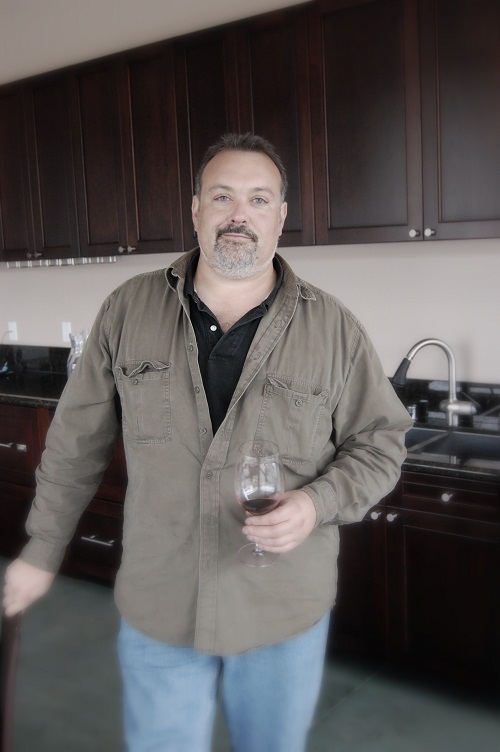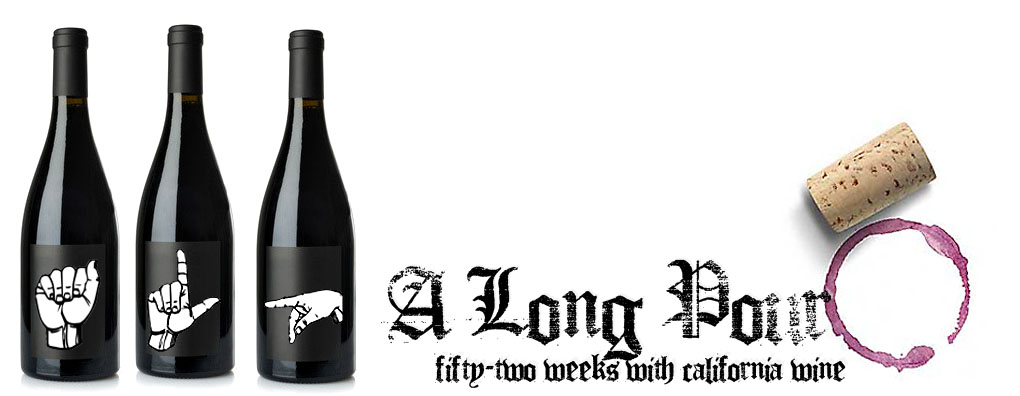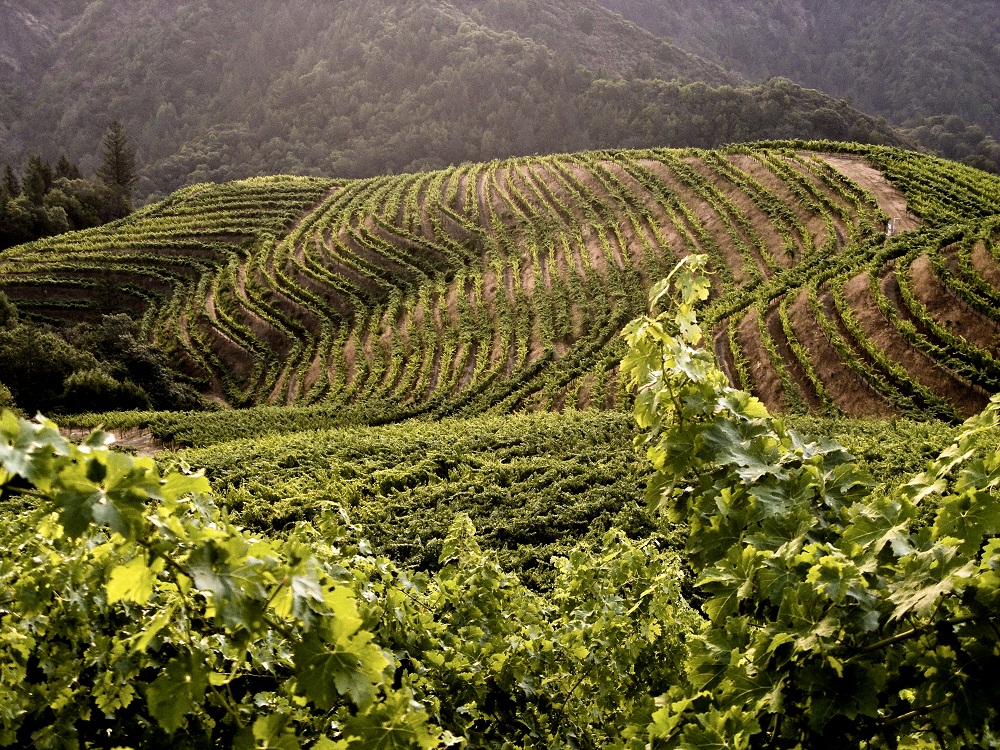Hidden Ridge – Art in Wine
I was late. I had just left the outskirts of Napa headed south on the 29 when my phone rang. I lingered too long at a lunch in Calistoga and was late for my next appointment. Winemaker Timothy Milos was on the other end.
“Just wanted to check in and see where you were at,” he asked. In addition to being late, I was also lost. After another phone call to clarify the directions, I finally arrived at the custom crush facility we had agreed to meet at. But this wasn’t where we were supposed to be.
We were supposed to be atop one of the most rugged and hard to access vineyard sites in California. Hidden Ridge Vineyard, as its name implies, it’s off the beaten path. It is in fact so far off the path that it is only accessible with vehicles much more all wheel drive than my Mazda3. In the rainy weather of this past December, when I visited the Napa Valley, the normally difficult roads became impossible roads and so we settled on the civilized streets of the custom crush facility where the wine is made.
I am, “all about the vineyards,” or so I tell people, and so I was disappointed to not be atop the peak of what is no doubt a breathtaking site. There was however, an unexpected windfall to my letdown.
First, the reason for my tardiness was an unexpected winemaker luncheon, (one of the best experiences of all of my travels, eating and drinking with winemakers and executives from Frank Family, Schramsberg, and others) and traversing the very steep slopes of Hidden Ridge would have been ill advised given the plenty of the wine at said event (driving probably was too).
Second, the lack of scenery (crush pads are not bucolic places per-se) left me no option but to pour my sensory observations into the flavorful wines we were sampling from barrel and bottle and the incredibly rich conversation Timothy and I enjoyed. The rustle of the wind was replaced by the hum of fluorescent lighting and the song of birds by the back-up warning of a forklift, but the conversation was unmatched.
If wine criticism is about summing up a wine, a producer, or a vintage with a few pointed sentences, A Long Pour is and always has been about barely scratching the surface of the story and people behind the bottle. If it is the vineyard that ultimately makes the wine, it is the conversation that makes the story. While there is no substitute for the right land, good wine, great wine, is more than just smart GPS coordinates. Wine of heart and soul comes from winemakers of heart and soul.
Timothy, a seasoned veteran of the Napa wine community, isn’t one of those, “let me tell you the percentages and math equations I use,” kind of winemakers, nor is he a “wait until you see our marbled tasting room,” kind of a guy either. He is, at his heart, a craftsman, a devotee to the art of wine, and more importantly the land that makes his art possible.
“Fundamentally it is just like a chef, it is about the ingredients,” he says, regarding the need for winemakers to avoid getting in the way of what the vineyard provides. “If you get in the way of your materials you loose what’s special about that [site]. It is my job to capture what I see in the vineyard, to understand what that place will do, and make it be its best.”
All too often, winemakers “get the credit for a great site,” he says. “Land first, viticulture second, winemaking third. I am the last in the line. I have a guiding force, I have a style impact, but the stone is handed to me from the vineyard.”
The “stone” was a reference to a story I relayed to him that winemaker Matthias Pippig of Sanguis told me last year. Some years ago, Matthias’ then young son asked him, “how do you make a stone look like an elephant?” Perplexed, Pippig answered, “I don’t know,” to which his cleaver son responded, “you cut away anything that doesn’t look like and elephant.”
As a winemaker, cutting away anything that didn’t look like an elephant made a lot of sense to Pippig and it became a metaphor for his own viticulture practices, literally cutting away any factors that don’t look like they will make great wine. It was a lesson not lost on the artistically inclined Milos. The most important part of the equation is the stone, the vineyard. Without the right stone the artist cannot have his elephant, the vintner his great bottle of wine. Without the vineyard, nothing is possible.
Hidden Ridge is such a stone. Spanning an elevation gain of 800ft and rising to a maximum height of 1,700ft on terraced slopes as steep as 55%, it is an isolated and rugged place to grow wine. It is ideal for the terroir driven Milos. The vineyard is unique not only in its geography, but in its isolation too.
“We’re not Alexander Valley, we’re not Chalk Hill, we’re not Dry Creek, we’re not Sonoma Mountain,” Timothy explained. “We are far enough from other grape growing areas that there is no appellation designation.”
In its unique isolation, there was a need for creative dedication to even get the project of the ground. Vineyard owners Lynn Hofacket and Casidy Ward, carved the terraces themselves, going so far as designing their own tractors to navigate the intense slopes. Theirs, was more than an investment of treasure, theirs was a sweat equity project, a gigantuine effort of will-power and moxi.
“It’s a different creature when people are personally invested,” Milos said of Lyn and Cassidy. “They are equally invested in doing it all…We are the only winery in California that has 4-wheel drive grape delivery trucks, reconditioned lumber trucks from Washington that Lynn and his guys built themselves.”
It is this extra attention on the vineyard that drives Hidden Ridge wines.
“Our goal is to express the vineyard,” Milos says of their style.” We tend toward the opulent, [the] rich; we tend toward the very ripe. We are looking for rich, well integrated mountain tannins, very ripe fruit. It’s ripe mountain Cabernet, in three words, that’s what we do.”
Of course, what Timothy means to say is, “these aren’t small Cabernets,” and yes their wines lean towards higher alcohol levels.
The alcohol debate has become something of a battle cry, both in traditional and new media. It is a call to arms I increasingly ignore as my small collection fills with 12.5’s, 13.5’s, 14.5’s, and yes a few 15.5’s too.
While I grow vexed with the endless debate and I do not subscribe to either camp (lower or higher), I was intrigued enough by some of his statements to ask Timothy about the controversy and what he made of it.
His answers were surprising to me in their clarity.
ALP: What do you think of the alcohol debate?
TM: “I think it sort of misses the point. What makes a high quality wine, what makes it an enjoyable experience is balance. There are wines that are balanced at 16% honestly, and there are wines that are balanced at 12%, and they are not going to be the same wines. We are never looking for high alcohol, we are looking for ripe fruit flavors and ripe tannins. Because of where we are (mountain top vineyard) in most years we are pushing 15% honestly.”
ALP: So the alcohol levels come with the ripeness you want?
TM: “Right. We are not looking for higher alcohol. I don’t even measure sugar until it comes into the winery.”
 “I was working at Mondavi and I had access to this old time grower. So my question was, ‘you have been in business since the 50’s. When did you pick grapes back in 1955?’ He said, ‘well the valley floors started coming in at the end of September and we usually finished the higher mountain sites at the end of October.’
“I was working at Mondavi and I had access to this old time grower. So my question was, ‘you have been in business since the 50’s. When did you pick grapes back in 1955?’ He said, ‘well the valley floors started coming in at the end of September and we usually finished the higher mountain sites at the end of October.’
“OK, well when do we pick now? Bottom of the valley floor maybe the end of September, mountain sites the end of October. It hasn’t changed, we aren’t waiting longer. What else has changed?”
“We went to virus free plant material and stopped using AxR, we went to different types of root stocks. AxR was a great root stock, you only got to 24.5% [brix], you carried a large a crop and you made fantastic wine. You do that with 101-14, you do that with 110R, you do that with 11-03, 5C, name your other rootstock and it will not carry the load and the sugars will spike higher by the time the fruit gets ripe.”
“It is a big part of the modern function of the vineyard, but that part of the equation never gets discussed. People want to blame winemakers for the change, but the change has happened for lots of reasons, not just because we want higher alcohol wines.”
“I think my job as a winemaker is to pay attention, not to impose. So where does the fruit taste the best? Where is the fruit actually mature? If you grow tomatoes in your backyard, do you want to pick those green? You can make fried green tomatoes, but if you want a ripe tomato that tastes like the full deal, you don’t pick it too ripe, but just before too ripe, it then has the most flavor. It’s pure physiology. The whole purpose of a grape to a vine is to have an attractive fruit that will attract mammals and birds to carry its seeds away. So the most flavor you are going to get is at the end of its life, before it collapses.”
“[Alcohol levels] are not as big of a factor as the debaters will have them be. This year, 2010, I have many vineyards that came in at 23.5% and I’m very happy with the balance in the wines, fully mature, picked the 26th of October right before the last rain storm.”
By now we had wondered into an area of the facility used to host groups and Timothy had me guess the alcohol content of a 2006 Hidden Ridge Cabernet he had opened. I knew where he was going with this; still I guessed high 13’s. It was actually 14.6%.
“The point being is,” Timothy then explained, “if the wine is in balance it doesn’t taste hot. A delicate wine can’t bare the heat of the alcohol, but a rich powerful wine can bear the heat.”
Throughout my time with him, Timothy struck me with his balance in views, telling me at one point that “the death of wine is uniformity,” and that we should “thank God for wine critics and Kermit Lynch.”
He summed up many of the debates surrounding wine this way:
“There is no one right answer, particularly in wine. Wine is in the metasphere of taste, wine is in the metasphere of opinion. The appreciation of wine is like any other art form. I like when it can rise to the occasion [of artistic form]. So much as my hands are dirty, it’s a trade, it’s a craft. I strive for art in wine, but I don’t disparage people that like work-a-day wine, or wines that I don’t care for because to me, they are appreciating the form. Whether you like Gauguin or not is beside the point, the fact that you are paying attention I think is the first step.”
Maybe we all need to pay attention more, to what is actually going on, to what is actually being said. Is it so wrong that there is so much diversity of opinion, does not one person’s perspective challenge the others? Is this not how we grow, how we change, how we get better?
It was grey and wet when Timothy and I parted ways. As always, the wines that were tasted fade on the palate, but the words remain. The gifts I receive do not come in a bottle, they come in experiences like this. That I have the chance to include a guy like Timothy Milos, who is smart, and funny, and charming, and talented, to the growing list of brilliant winemakers I have sat and conversed with is a great privilege, one I wouldn’t trade for anything.





What a great story! I agree with Timothy. The key to knowing whether a wine is good or not is balance. How does everything come together (fruit, acidity, alcohol, tannin, finish)? That’s how you judge a wine, not just off personal preference.
And as a person who writes about wine myself, I love the statement “The gifts I receive do not come in a bottle, they come in experiences like this.” At the end of day it’s not about what wine I’ve sampled with a particular food, its about sharing a moment with someone, opening myself up to the world or to a particular experience and enjoying the journey.
Cheers!